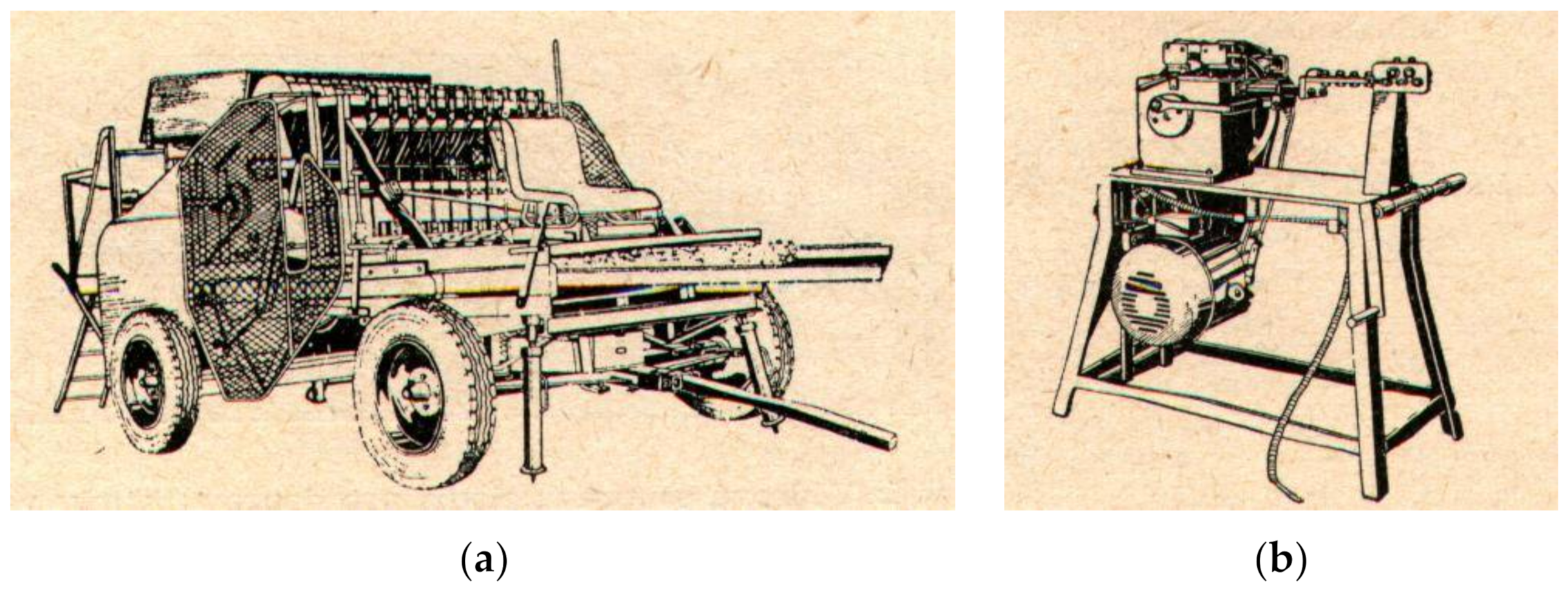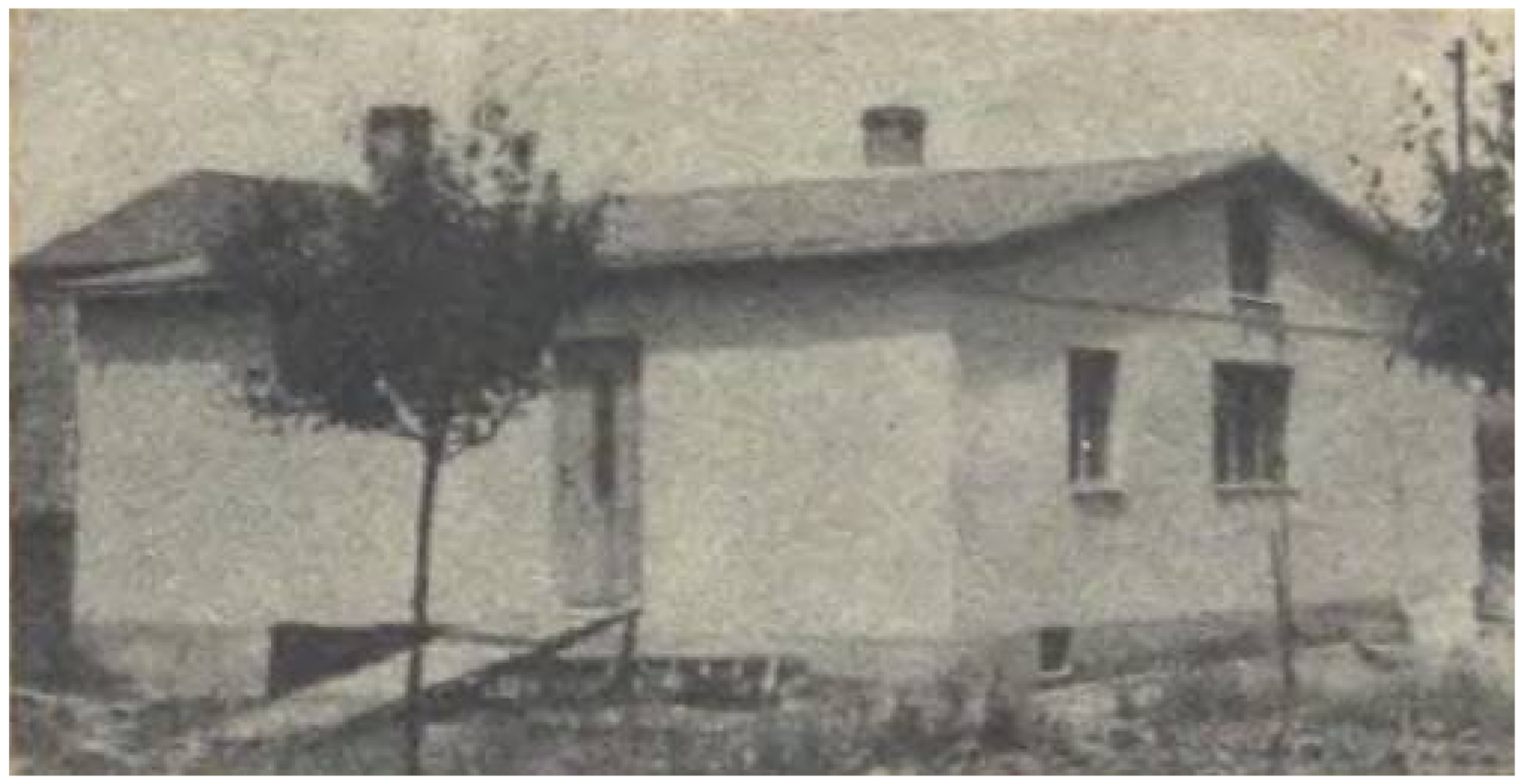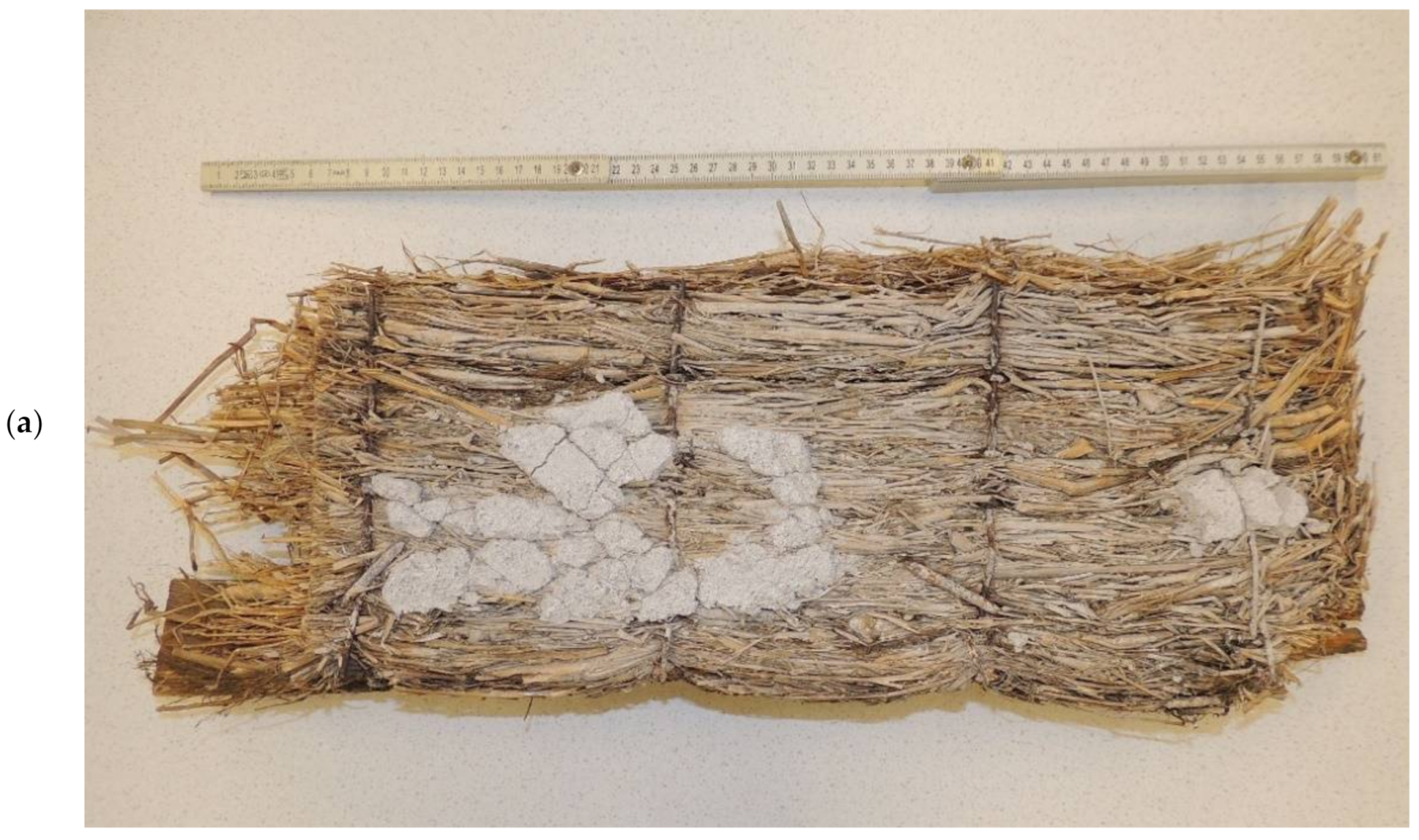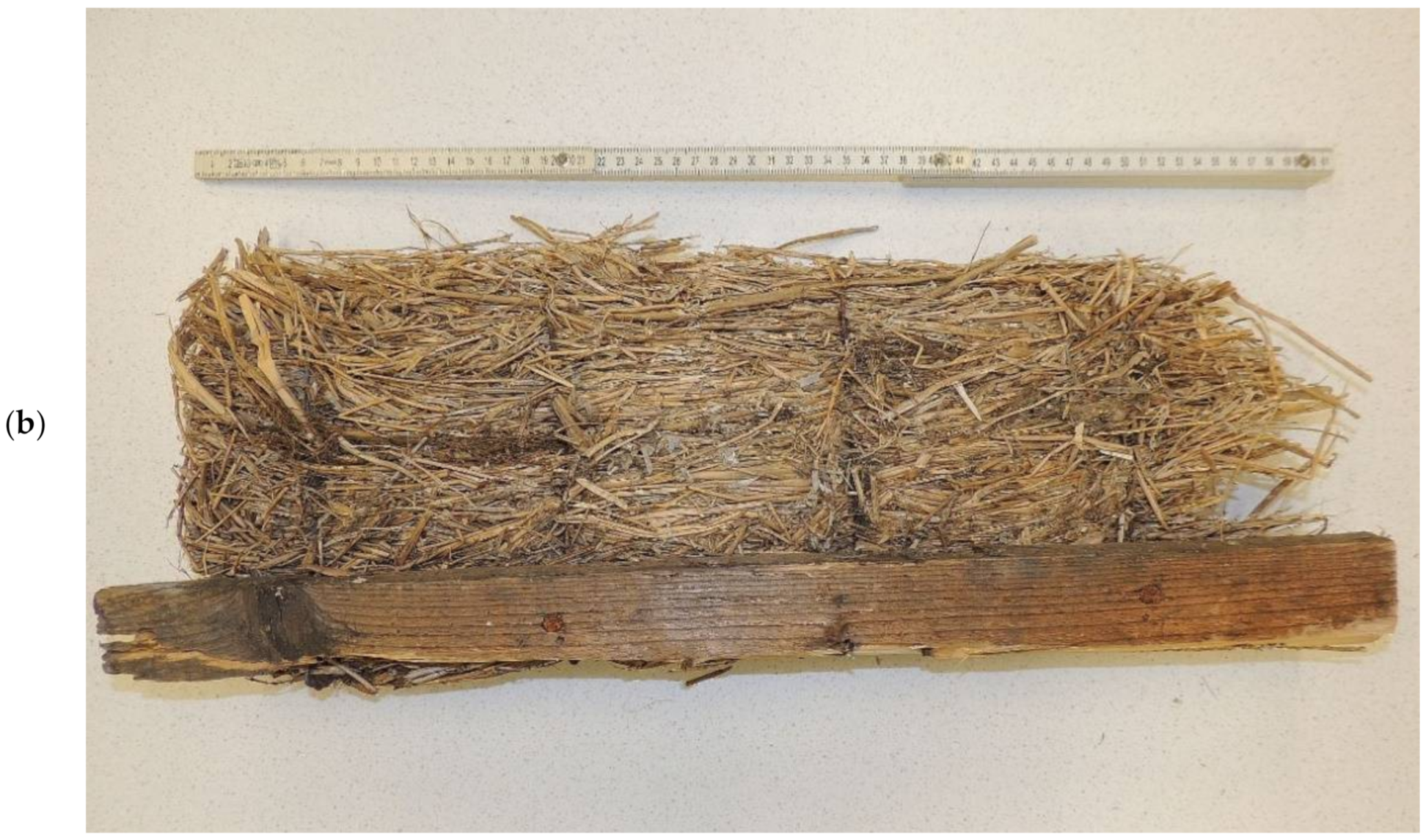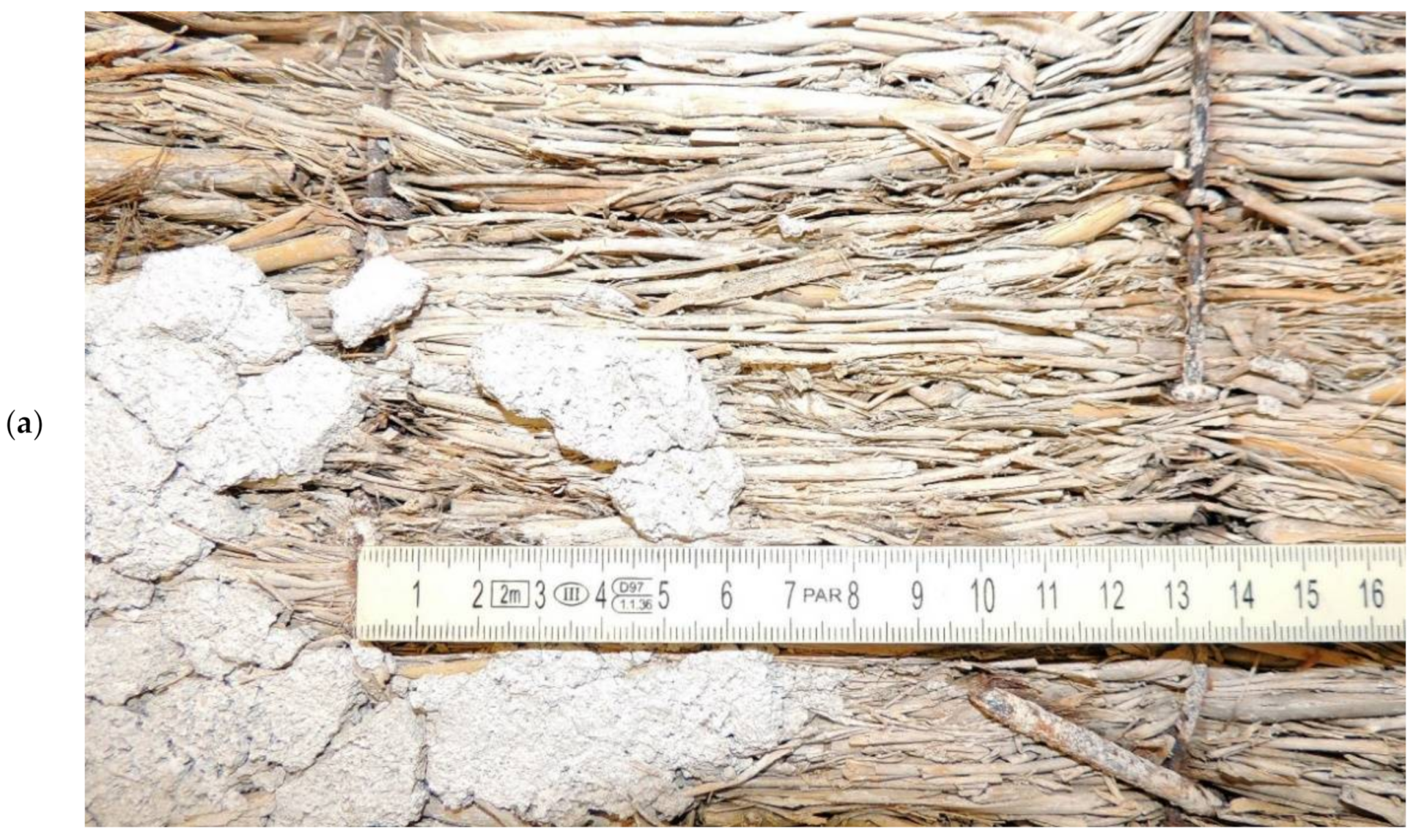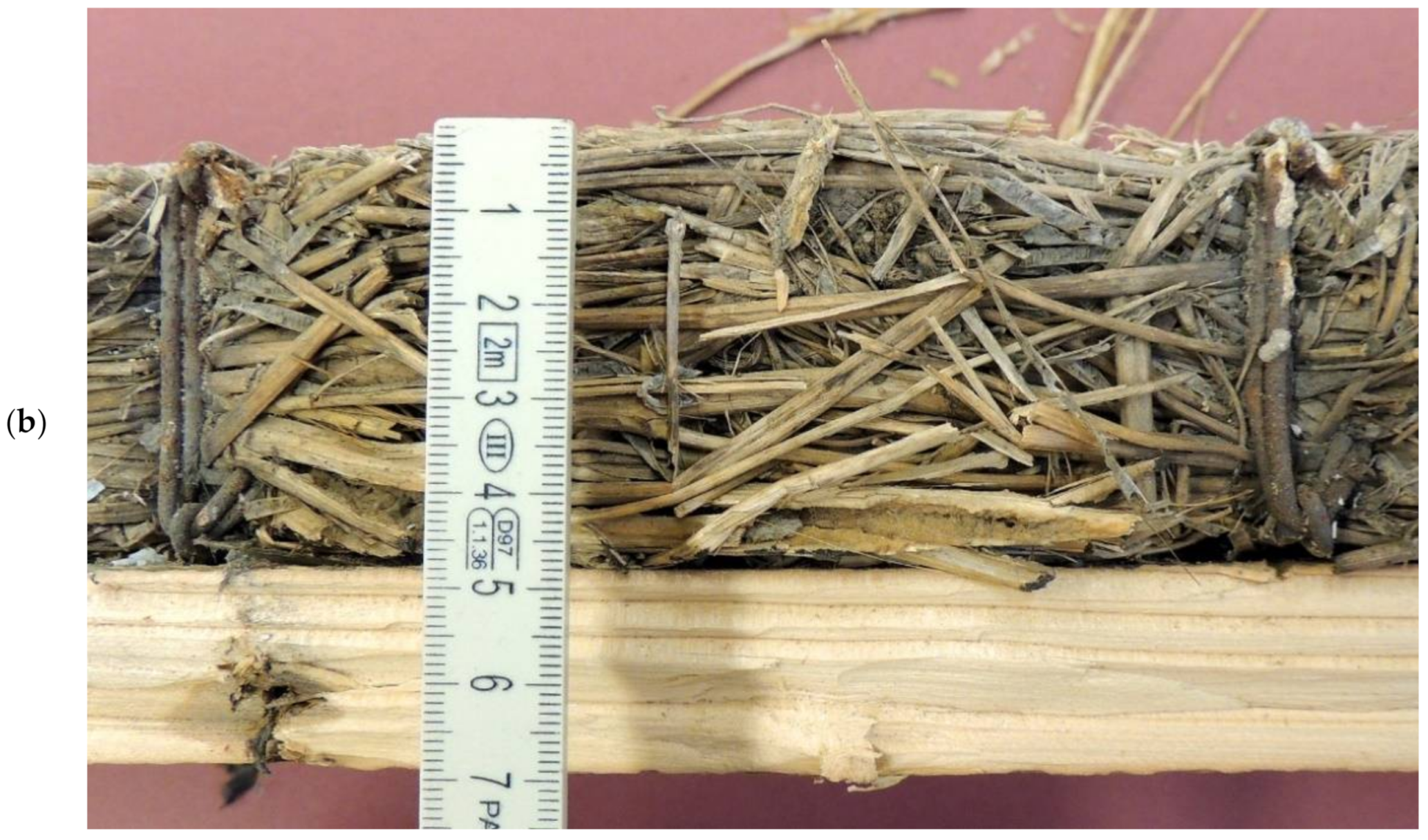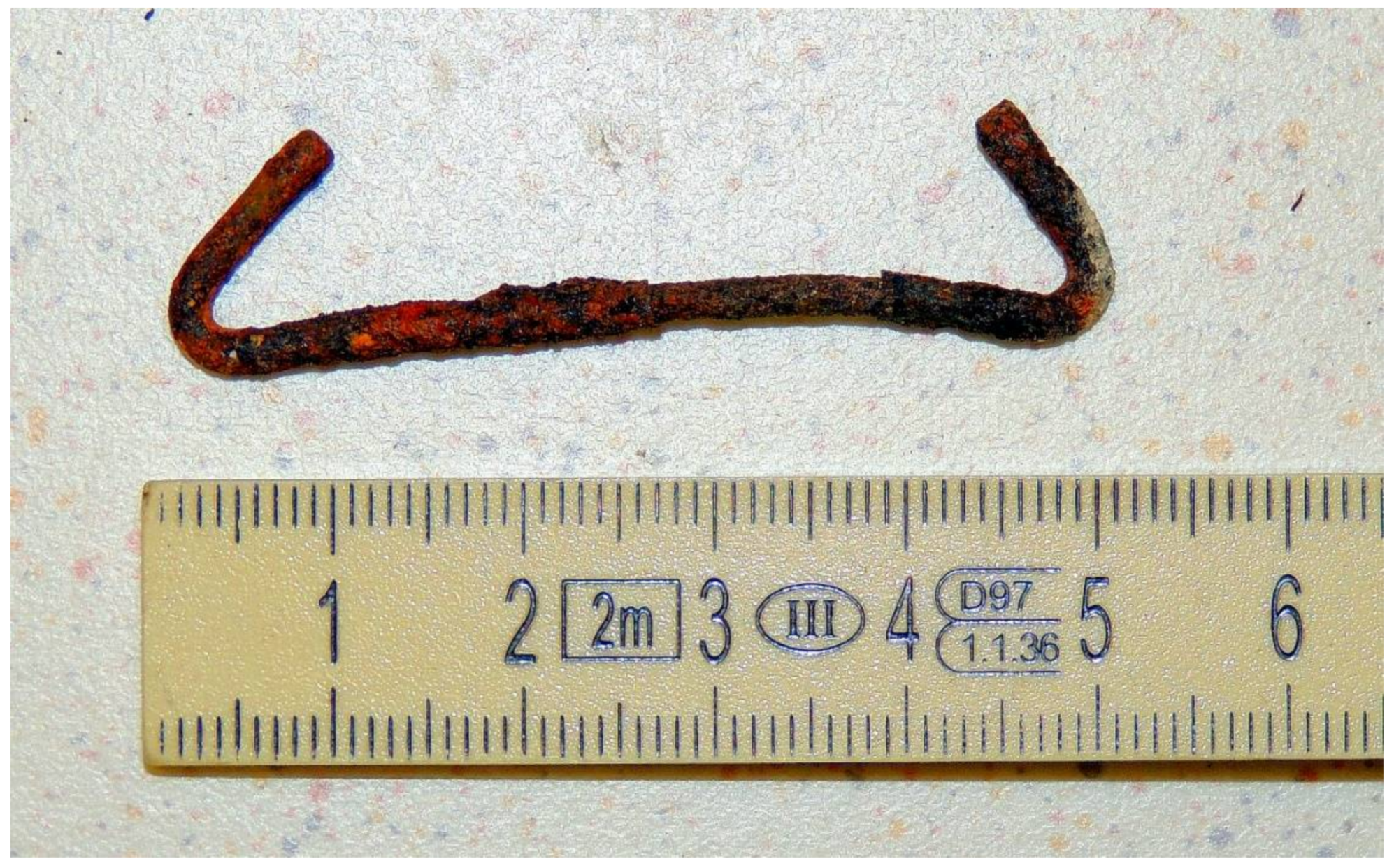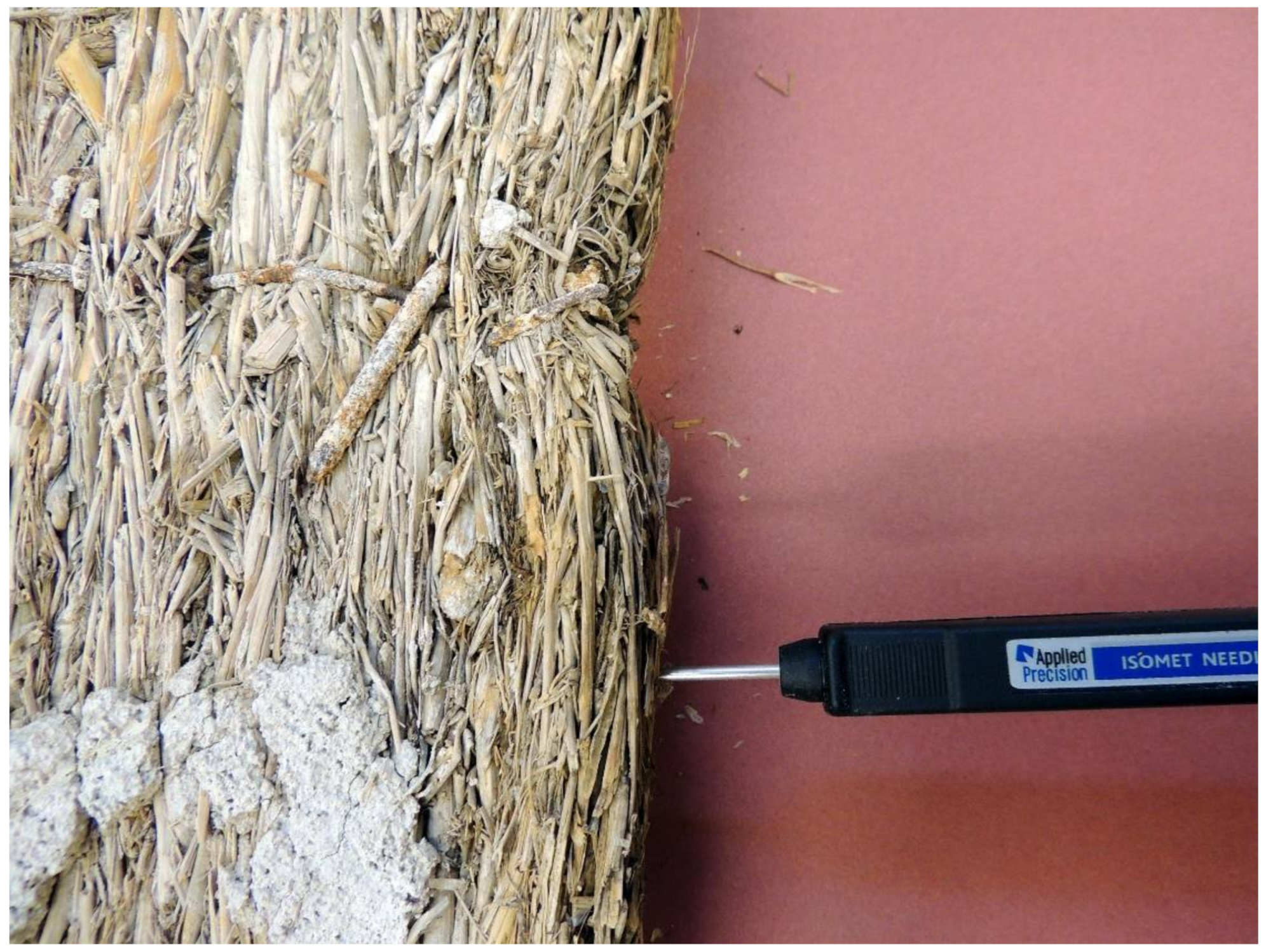This paper aimed to monitor a hundred years of production of panels for which the name SOLOMIT was used, and generalize the reasons for their long-term production. It also intended to reflect on the service life of constructions using this technology.
Efficient energy management requires both the acquisition of energy and the reduction of energy consumption in all economic sectors. A significant share of energy consumption is the energy used for heating or cooling in the summer. This requires the improvement of the thermal-technical properties of buildings by using suitable thermal insulation.
Therefore, sustainable development involves not only the use of renewable resources but also the use of materials that are natural, ecological and renewable. One of these sources is straw, the production of which in the cultivation of cereals and rapeseed is inevitable, but still underappreciated. In particular, rapeseed straw is not very well-utilized. Ways of its energy use by combustion are being sought, while there are many years of experience with its application as a cheap and at the same time high-quality insulating material in construction.
The use of local natural raw materials for building has an age-long tradition in architecture. Wood, stone, and fired or unfired clay were the basic materials of structural frame elements in construction. Straw, hay, and reed were used as fillers, mainly to reduce the heat loss of buildings. Mixtures of these materials (e.g., clay and straw) were also used very often. Thermal insulation materials were sometimes molded into building components, but more often, they were stored loosely in the spaces adjacent to premises for the living of people and farmed animals.
1.1. Interwar Period
In 1920, engineer Émile Feuillette designed a house with a wooden structural frame and straw thermal insulation. The construction was built in the French city of Montargis [
13].
In 1923, building panels made of plant fibers were introduced into the French market under the trademark SOLOMIT by the company Société Anonyme Solomite. Their production and installation were covered by several patents filed in Paris by a Russian emigrant, Sergei Nicolajewitsch Tchayeff (born 15 September 1863, in Moscow). For example, in 1923, it was the patent FR567564A Compressed and Reinforced Straw Panel Making Machine (granted in 1924) [
14]. A relatively revolutionary idea of this technology was the use of steel staples in the production of building panels from plant fibers.
The name SOLOMIT refers to machine-pressed panels made of natural materials (most often cereal, mustard, or rapeseed straw), which were tied with steel, often galvanized, staples. Single-purpose staple-making machines were used to produce the staples. The thermal conductivity is affected by density. The value of the thermal conductivity coefficient stated for the panels is most often in the range of 0.081 to 0.151 W·m
−1·K
−1 [
15]. The stated values assume a material moisture content of up to 5%. The panels were often labeled as non-flammable, and suitable as sound insulation [
4,
5,
6,
7,
8,
9,
10,
11,
12,
13,
14,
15].
The expression SOLOMIT is probably derived from the Russian word straw (coлoмa—soloma). This word sounds similar in other Slavic languages: Bulgarian cлaмa—slama, Czech sláma, Polish sloma, Slovak slama, Slovenian slama, Serbian cлaмкy—slamku and Ukrainian coлoмa—soloma.
The reason for the emergence and rapid spread of the building panels made from available and relatively cheap raw materials throughout France was the lack of housing after the Great War. SOLOMIT was used not only for cheap housing construction, it was also utilized in the construction of buildings for trade and industry.
An example of the use of SOLOMIT in the modern architecture of the 1920s is the model house of the architect Le Corbusier, called the Pavilion de L ‘Esprit Nouveau. It was built in Paris in 1924–1925 to house an international exhibition of modern decorative arts. On this project, Le Corbusier also cooperated with Tchayeff [
16]. Panels made of pressed SOLOMIT were attached to the concrete structure. Le Corbusier designed it with the intention of dismantling it after the end of the exhibition and rebuilding it in the Paris suburbs [
17].
Another example of a building, in which Tchayeff was involved, is the Church of the Resurrection in Meudon (Paris), rue des Bigots. Its foundation stone was laid in 1928. It was built for the Russian Orthodox Church [
16].
Manufacturing technology began to spread quickly throughout the world. As early as 1924, the United States Patent Office granted Serge Tchayeff a patent No. 1,489,678—Method of and Apparatus for Making Material for Construction Purposes [
18].
Sergei Tchayeff’s patents were also registered in Poland. For example, on 13 February 1931, a patent Urządzenie do zakładania klamer na druty przy wyrobie prasowanych i uzbrojonych płyt i belek ze słomy i trzciny (Device for placing staples on wires for the production of pressed and reinforced straw and reed panels and supports, France, 1928) was registered under No. 13061 [
19]. On 18 March 1932, the patent Sposób wyrobu płyt budowlanych (The method of manufacturing building panels, France, 1926) was registered under No. 16006 [
20].
The use of natural materials, and thus also of SOLOMIT, in Italian architecture of the 1920s and 1930s is mentioned in [
21,
22].
An example of the use of SOLOMIT panels in Spanish architecture on the turn of the 1920s and 1930s were the Madrid buildings at Calle Velázquez No. 31 and at Calle Abascal No. 47 [
17].
In the Netherlands, SOLOMIT was first used in 1928. However, it was not officially introduced in this country until 1930 at the Jaarbeurs exhibition center in Utrecht [
23].
The introduction of SOLOMIT into the Czechoslovakian market was supported by the post-war (the Great War) friendly relations with France, and the German neighborhood. Since 1934, SOLOMIT was produced by the company Rákosárna (translation: reed processing factory) in the town of Městec Králové [
24]. For example, in the years 1931–1934, a project of the so-called French schools was carried out according to the design of the architect Jan Gillar. The SOLOMIT panels, 5 cm thick, were used during construction as fillers in the walls dividing the classrooms [
25]. The architect was apparently using these panels to reduce the noise spreading. Since 3 May 1958, these buildings were located in Prague—Dejvice, Bílá street, No. 1784/1, and it became a protected heritage.
The use of SOLOMIT was not always without problems. On 16 October 1931, after a fire in several houses in Czechoslovakia, where SOLOMIT was used for construction, firefighters performed tests on the fire resistance of this building material in the village of Roztyly (today a part of Prague). The fire resistance advertised by the manufacturer was not confirmed, and the firefighters declared the material as flammable [
26]. The possible cause of that was that, already during the manufacturing, spraying of SOLOMIT panels with flame retardants was abandoned.
Information on the use of SOLOMIT in the building industry and the technology of its manufacturing also spread in the Soviet Union. In [
27], from 1937, SOLOMIT is mentioned in connection with the protection of buildings made of natural materials against moisture.
In Germany, SOLOMIT was produced in Berlin since 1929. It was used to expand city apartments and improve thermal insulation. During the interwar years, especially with the onset of the Great Depression, SOLOMIT was used in Germany to build urban peripheral settlements [
16].
Low costs and raw material availability were probably the reasons for using SOLOMIT to build accommodation facilities for workers on the outskirts of the city of Kiel in Germany. Blocks of buildings for shipyard workers, who were carrying out war military contracts, were similar in arrangement to military accommodation camps. Several such camps were built in the years 1939–1942. During World War II, the houses accommodated forced laborers from abroad. In September 1944, many buildings were damaged by allied air attacks. In the post-war period, these houses became a shelter for the socially disadvantaged. In 1956, the replacement of the original buildings with simple brick buildings began. The last house built from SOLOMIT was demolished in 1974, but the name Lager SOLOMIT lasted until the demolition of the brick buildings in the late 1980s [
28].
After 1935, under a license from Germany, SOLOMIT was also produced in South Australia. A possible model for Australian demonstration buildings from SOLOMIT was the housing of craftsmen designed in the early 1920s by the Swiss-French architect Le Corbusier (1887–1965). The history of the use of SOLOMIT in Australia is described in detail in [
16].
1.2. The Period after World War II
During the Second World War, SOLOMIT production was reduced in most countries, because of the orientation of the industry towards war production, and the lack of manpower. After the end of the war, the manufacturers tried to resume the production. Once again, the construction of flats in war-torn areas needed to be carried out cheaply and from available resources. However, modern materials’ competition was growing.
In 1952, SOLOMIT was used as lost formwork and an operational noise barrier when constructing the Zutphen station in the Netherlands. During the building reconstruction, SOLOMIT panels (50 mm thick, 4 m long, 1.5 m wide) were exposed on the ceiling of today’s café to give it a decorative appearance [
23].
In 1990, the Australian experience with SOLOMIT was referred to in [
29]. It presented the thermal conductivity of SOLOMIT λ = 0.041 W·m
−1·K
−1 at a density of 213 kg·m
−3. The author mentioned the frequent use of SOLOMIT in the early 1970s as a ceiling material in lightweight buildings of primary schools and some childcare centers.
The architectural use of SOLOMIT panels manufactured in Australia is also described in [
30]. The author presented SOLOMIT as a product mainly from South Australia. The suitability of 50 mm thick panels in ceiling structures for its thermal insulation and acoustic properties is also mentioned here. The author also mentioned other valuable features such as low maintenance, attractive color and structure and cost-efficiency.
The revival of SOLOMIT production after World War II in Czechoslovakia can be considered as a separate chapter, and it follows on the pre-war experience. The forced collectivized agriculture in the 1950s and 1960s required building of a large number of high-capacity, but still cheap, stabling structures for animal production.
Until the mid-1950s, fattening farms were built according to individual designs. Adaptations of barns for the purpose of pigs’ free-fattening (i.e., without pens) on deep bedding with feeders and drinkers at the perimeter walls, requiring minimal cost for adaptation, were also very common until the end of the 1950s. New types of test constructions began to be built only in the middle of the century. At the end of the 1950s, five standardized pig-fattening farm designs with a capacity of 200 to 800 were available to the farmers (types: 200-3, 400-1, 12-T/58, T-218 and T-218 a). A coherent range of fattening farms with a capacity of 600, 950 and 1200 pigs was not developed until the early 1960s. SOLOMIT panels were used quite often in the construction of pig-fattening facilities [
31]. For example, the costs of constructing a pig farm for 450 animals were halved due to using SOLOMIT [
32].
Since 1956, on this basis, the first standardized designs of breeding farms also appeared. Farmers could choose from three standardized lightweight construction designs for breeding pigs. Local materials were used for the construction, i.e., wood, often rye or reed thatch as well, and the SOLOMIT panels. These were simple sheds with a gable roof, either completely without or with low perimeter walls. Lightweight breeding farms were constructed for higher numbers of breeding pigs, and they had an internal arrangement identical to the fattening farms and were connected to paddocks for grazing in the same way as sheds and double sheds.
Agricultural enterprises used SOLOMIT panels not only for the construction of pig farms, the panels were also used in the construction of cattle breeding farms, poultry houses and apiaries. The expected lifetime of these buildings was a maximum of thirty years. Nevertheless, many of them, although in an altered form, were preserved until the first decade of the 21st century. It was rarely used for the same or similar purpose for which it was built [
31].
An example of a building for cattle from 1958 was a free stable for young cattle in the village of Libějovice (
Figure 1). Various construction technologies were tested on the construction site. The south wall was constructed using SOLOMIT panels, which were surface-protected with Lignate (refractory fiber-cement composite). The other walls of the stable were made of bricks.
The company Rákosárna in the town of Městec Králové continued in the production of SOLOMIT in Czechoslovakia also after World War II. In the 1950s, it processed rape straw, which is hardly usable especially in agricultural enterprises [
24]. From 100 kg of this raw material, it produced 5 m
2 of panels with dimensions (250 × 160 × 5 cm). After both-sided plastering, the resistance of these panels to moisture, fungi and pests was advertised. Fire resistance was again mentioned in the press at that time. The thermal properties of the both-sided plastered version were compared with a 0.7 m thick brick wall [
31].
The SOLOMIT panels, which were produced in Czechoslovakia, were characterized in the literature as panels made of dry plant fibers (straw, reed, rape, etc.), pressed under a pressure up to 0.7 MPa. They were fixed and reinforced on both sides with galvanized steel wires with a spacing of 13.5 cm, tied together with staples passing through the panel. These panels were made up to 160 cm wide, 200–250 cm long and up to 5 cm thick [
33].
In the 1960s, due to the limited capacity of the centralized manufacturer, and with the aim to reduce the transport costs, a mobile set of production machines (
Figure 2) was offered in the catalogue of the company [
34]. Seven people were needed to operate the production line. The produced panels were 1.4 m wide, 5 cm high and the length was according to the setting. Galvanized steel wire with a diameter of 2 mm was used for binding. In eight hours, the line produced panels with a total length of 180 m.
Some agricultural enterprises set up their own production capacities and offered SOLOMIT panels also for building prefabricated family houses and cottages (
Figure 3).
An operational verification of the high-capacity stables in Czechoslovakia was carried out even by the state research organizations. For example, in the 1950s and 1960s, the Research Institute for Pig Breeding Kostelec nad Orlicí evaluated the buildings from SOLOMIT used for pigs’ stabling in operating conditions. It can also be found in [
24] that a double SOLOMIT panel was recommended for the construction of non-tempered stables for pigs, and a single panel with both-sided plastering for lightweight plastered constructions.
1.3. Present Time
The fact that SOLOMIT is still in the consciousness of the professional public is also evident from a mention in a book published in 2018 in Russia. It was reported in connection with the use of natural materials in the building industry [
35].
Another author [
21] favored returning to historical technologies using natural thermal insulation materials in the building industry. The author also dealt with reconstructing buildings that were built using natural thermal insulation materials in the past.
At present, Australia can be considered the center of SOLOMIT production. The company SOLOMIT STRAWBOARD PTY. LTD (Dandenong, Victoria, Australia) manufactures panels for the construction of acoustic ceilings. The raw material for their production is clean wheat or oat straw. The compressed straw sheets are reinforced with galvanized wires, which are held in place by galvanized wire stitches. The panels are manufactured with a thickness of 25 and 50 mm, a length of 1200–4000 mm and a stock width of 1200–1220 mm (special widths 820–1200 mm). The manufacturer advertises the material density for straw acoustic ceilings as 161 kg·m
−3 and the thermal conductivity as λ = 0.057 W·m
−1·K
−1. According to Australian law, the fire resistance of the panels corresponds to a level required for common residential buildings. An inflamed SOLOMIT does not continue to burn, but carbonizes [
4].
The company also produces fence panels using the same technology. The row material is brushwood stems. The thickness of the panels is 25 or 50 mm. The standard size of the fence panel is 1800 × 1800 (1500) mm, with the weight of 65 kg. The manufacturer assumes a service life of 20–30 years [
4].
The principle of SOLOMIT manufacturing varies around the world. An example of the production of reed panels in the territory of the Russian Federation, which are being fastened by steel staples, can be found in [
36]. Additionally, Reference [
37] confirms that SOLOMIT production is currently concentrated in Australia and Asia.
As already mentioned, rapeseed straw was very often used for the production of SOLOMIT boards. Its current worldwide production can be derived by considering the ratio of harvested grain (1 t) and straw (1.2–1.8 t) from
Table 2. Part of the rapeseed straw is used for energy purposes (pellet production). However, a significant part of it is already crushed at harvest and subsequently ploughed.
In recent years, the use of cereal straw has also become interesting for various industries and agriculture. Apart from the classic use in agriculture as a bedding material [
38], its application can be very versatile, e.g., packaging material [
39]. New forms of straw use are being sought, for example, in construction as an insulating material [
40,
41].
In some cases, an attempt is made to combine various plant materials and other substances of organic origin with conventional building materials, such as cement, lime, gypsum, etc., and it is thus possible to obtain interesting composite materials [
42]. However, not only the development of new materials but also the research of the basic technical properties of these new building materials is also very important [
43].
The use of plant-based materials is being mentioned more and more often in connection with the determination of the carbon footprint of building materials. The construction of buildings that would function as carbon storage is being considered. In this context, it should be noted that a study [
37] published by the Carbon Leadership Forum at the University of Washington identified SOLOMIT as a carbon-positive future material.
1.4. The Service Life of Constructions Using SOLOMIT
There is some indirect evidence on the issue of the service life of constructions using SOLOMIT panels. The houses for workers built in Kiel, Germany [
28], in 1939–1942, could be mentioned, where the last was demolished in 1974. The SOLOMIT used in constructing the Zutphen station (in 1957) in the Netherlands outlasted its reconstruction and is part of the building up to the present day [
23].
Reference [
24] provided an estimation of the service life of agricultural buildings using SOLOMIT panels in their construction. The wooden structure of these buildings was covered on the outside with SOLOMIT panels. The author stated that with a correct design of the thermal insulation of the building and sufficient ventilation, it is possible to expect a service life of 8–12 years for light temporary buildings and 20–25 years for permanent buildings.
During the reconstruction of a light building (a cottage) in 2016, the authors of this paper managed to obtain a sample of the SOLOMIT panel. The building was built in the 1950s/1960s of the 20th century. A similar building is presented in
Figure 3. For constructing these types of buildings, a wooden structure (timber construction) was usually used, and SOLOMIT panels formed the facades of the outer walls. A classic lime-cement mortar was applied for the external plastering, usually with a rustic surface treatment of a thin layer, resistant to weather conditions. The internal insulation and modification depended on the purpose of the building. Wood or wood-based panels were often used, which in recreational facilities, used mainly in the summer, well met the thermal-technical and aesthetic requirements.
The finding condition of the sample (approximately 0.6 m long, 0.2 m wide and 0.05 m high) is documented in
Figure 4. Rapeseed straw was the original material for producing the panel. The binding was made using steel staples and warp steel wires (
Figure 4,
Figure 5,
Figure 6 and
Figure 7). From the remnants of the wire, it can be concluded that the binding was realized with a wire stated in [
33,
34] (galvanized steel wire with a 2 mm diameter). The sample included the remains of a wooden structural frame and plaster. The edges of the sample were damaged in the disassembly. The part of the sample bounded by three warp wires and five staples on each warp wire could be considered coherent. The panel height (50 mm) and the spacing of the warp wires corresponded to the values reported in the literature [
33].
The authors tried to determine the thermal conductivity of the obtained sample. Regarding the condition of the sample (remnants of mortar and wooden structures) and its tendency to crumble, the portable device Isomet 2104 in a set with a needle sensor (Applied Precision, Ltd., Bratislava, Slovakia), with which the authors’ workplace was equipped, was chosen for its determination. The device is characterized in the literature [
45]. When inserting the needle into the center of the sample height, the manufacturer’s requirements were met, i.e., the layer of material around the needle sensor must be at least 15 mm thick and the 80 mm needle sensor must be fully inserted into the material (
Figure 7).
The measurement took place in the laboratory of CULS in Prague. The sample was stabilized to ambient temperature before each measurement. Prior to measurement, the mass moisture of the material was determined with the FH A696–MF and ALMEMO 2690-8 instrument sets (Ahlborn GmbH, Holzkirchen, Germany). Subsequently, the material temperature was determined by a needle sensor of the Isomet 2104 device (
Figure 7). After the end of the temperature measuring cycle, the device was switched to the thermal conductivity measurement mode, and the cycle was started. In parallel with this measurement, the temperature and relative humidity of the air in the laboratory were determined with the FHA 646-21 and ALMEMO 2590-9 instrument sets (Ahlborn GmbH, Holzkirchen, Germany). The needle sensor was gradually inserted into various places in the sample following the device manufacturer’s methodology. Six measurements were carried out with the sensor inserted across the predominant direction of the compressed stalks, and five measurements were performed with the sensor inserted parallel to the predominant direction of the compressed stalks (this measurement corresponded to the direction of heat flow of the mounted panel). With the sensor inserted parallel to the direction of the stalks, an interval of 0.0511–0.0813 W·m
−1·K
−1 was determined for the specific thermal conductivity (95% probability considered). With the sensor inserted across the direction of the stalks, an interval of 0.0750–0.1028 W·m
−1·K
−1 was determined for the specific thermal conductivity (95% probability considered). A more detailed description of the experiment was provided in [
45]. It should be noted that the experimental conditions did not comply with EN 12667 and that the result can only be considered indicative.

